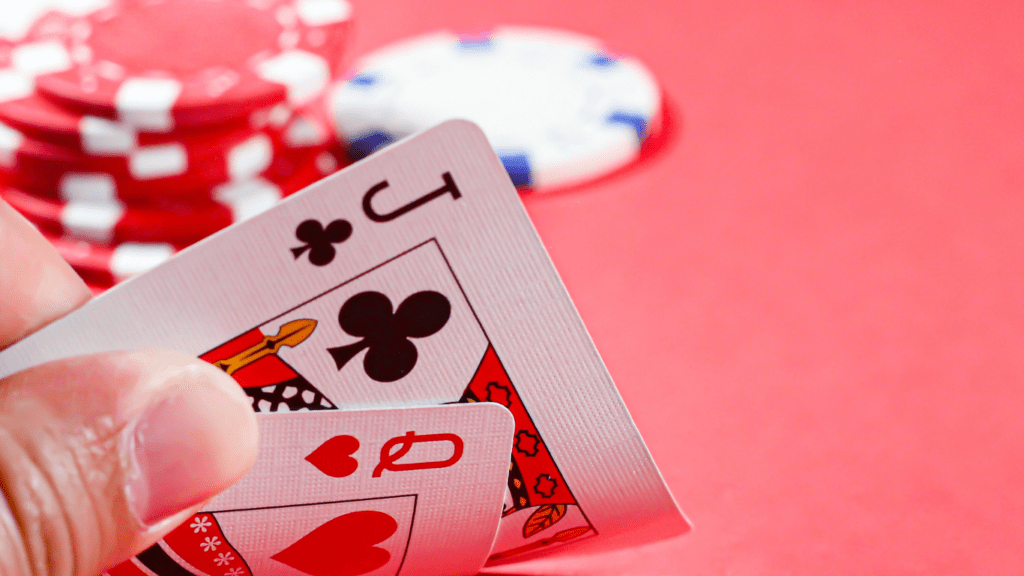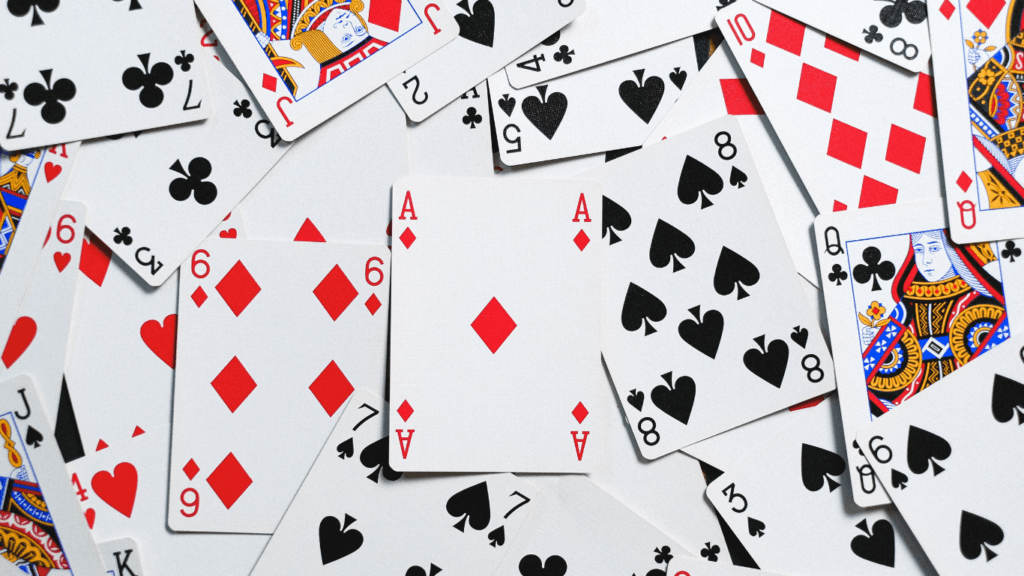The Basics of Blackjack
Understanding the fundamentals of blackjack strategy is essential. My goal here is to provide a clear guide to the basic rules and strategies.
Objective of the Game
In blackjack, the objective is simple: achieve a hand value closer to 21 than the dealer’s without exceeding 21. I focus on two main actions to guide my decisions—hitting and standing.
Card Values
Each card in blackjack has a specific value:
- Number cards (2-10): face value
- Face cards (Jack, Queen, King): 10 points each
- Aces: 1 or 11 points, depending on what benefits the hand
Hitting and Standing
Hitting involves taking an additional card to increase hand value. I hit when my hand totals 11 or fewer. Standing means keeping my current hand and concluding my turn. I stand when my hand is 17 or higher, as getting closer to 21 without busting is likelier.
Doubling Down
Doubling down lets me double my bet in exchange for committing to stand after receiving one additional card. I double down on a starting hand value of 10 or 11, optimizing my chances of improving the hand with a high card.
Splitting Pairs
Splitting pairs creates two separate hands when dealt a pair of identical cards. Each hand receives an additional card, and I play each independently. I split pairs of Aces or 8s, as these combinations improve winning chances.
Dealer Rules
In blackjack, dealers follow set rules. They must hit on hands totaling 16 or less and stand on 17 or more. Understanding this helps predict the dealer’s moves and informs my strategy.
Basic Strategy Chart
A basic strategy chart provides the statistically optimal action to take in every possible scenario. By memorizing or consulting this chart, I ensure my decisions are mathematically sound.
| Hand Value | Dealer’s Upcard | Action |
|---|---|---|
| 8 or less | Any | Hit |
| 9 | 3-6 | Double Down |
| 10 | 2-9 | Double Down |
| 11 | 2-10 | Double Down |
| 12 | 4-6 | Stand |
| 13-16 | 2-6 | Stand |
| 17 or more | Any | Stand |
| A, 8-10 | Any | Stand |
Understanding these basics establishes a solid grounding in blackjack strategy, sidestepping common pitfalls.
The Importance of Basic Strategy
Basic strategy is crucial in blackjack. It provides the mathematical best action for any given hand, improving your odds and minimizing the house edge. Without it, decisions become guesses rather than strategic moves.
Card Counting. Basic strategy serves as a foundation before mastering more complex techniques like card counting. It’s essential to earn consistent success.
Avoiding Common Mistakes. New players often make errors, such as hitting when they should stand. Basic strategy helps avoid these pitfalls.
Saving Money. Proper use reduces losses. For instance, always doubling down on an 11 against a dealer’s weak card maximizes returns over time.
Ease of Learning. Unlike other casino games, blackjack’s basic strategy can be learned relatively quickly. Charts and tables provide quick references, making it accessible to beginners.
Maximized Winnings. Even experienced players benefit. Consistently applying basic strategy ensures you make the most profitable decisions.
Basic strategy is indispensable. It turns blackjack from a game of chance into one of skill, enabling informed actions that enhance your gameplay.
Key Principles of Basic Blackjack Strategy

Understanding basic blackjack strategy involves mastering several key principles. These principles guide players in making the best decisions to improve their odds against the dealer.
When to Hit and Stand
Hit and stand decisions are foundational in blackjack strategy. Players hit when their hand value is low and stand when it’s high. For example, always hit if your hand totals 8 or less. Always stand if you have a hard 17 or higher. Consider the dealer’s upcard: hit if the dealer shows a strong card (7 through Ace), stand if the dealer shows a weak card (2 through 6).
When to Double Down
Doubling down can maximize profits in favorable situations. Players double down when they believe they have an advantageous hand. For instance, double down if you have a total of 10 or 11 and the dealer shows a card between 2 and 9. Additionally, double down on a soft 16-18 if the dealer’s upcard is 4, 5, or 6.
When to Split Pairs
Pair splitting is a crucial element of basic strategy. Players split when their hand consists of two cards of the same value. Always split Aces and 8s. Aces can become powerful with additional cards, while splitting 8s mitigates the risk of a weak total of 16. Avoid splitting 5s and 10s; treat these pairs as a 10 or 20, respectively.
Understanding Surrender
Surrender can save players from significant losses. It’s an option to forfeit half the bet and end the hand. Surrender in scenarios where the likelihood of losing is high. For example, surrender if you have a hard 16 and the dealer shows a 9, 10, or Ace. This strategy reduces potential losses in tough situations.
Using these principles consistently helps players make optimal decisions and improves overall gameplay.
Common Mistakes to Avoid
Understanding frequent mistakes is crucial in refining blackjack strategy. These errors impact gameplay and outcomes, so avoiding them becomes essential.
Ignoring Basic Strategy Charts
Basic strategy charts guide optimal decision-making. Some players neglect these charts, making uninformed choices. Referencing these charts improves odds against the dealer.
Misjudging Hand Values
Misinterpreting hand values leads to poor decisions. For instance, holding a hand totaling 16 against a dealer 10 upcard often requires hitting rather than standing. Accurate hand evaluation ensures better gameplay.
Improper Bankroll Management
Not managing bankroll properly risks losing more than intended. Set a budget and stick to it. Avoid chasing losses, and know when to stop playing to preserve funds.
Splitting Pairs Incorrectly
Pair splitting rules vary based on hand and dealer upcard. For instance, always split aces and eights. Conversely, never split tens and fives. Following these guidelines maximizes winning potential.
Failing to Adjust to Table Rules
Different tables have unique rules affecting gameplay. Understand specific table rules, including dealer hitting on soft 17 or surrender options, to align strategies accordingly.
Overvaluing Insurance Bets
Insurance bets against a dealer’s ace rarely favor the player. These bets increase house edge and usually lead to losses. Focus on optimal play rather than side bets.
Emotional Decision-Making
Emotional decisions undermine logic and strategy. Stay composed, and rely on established strategies rather than reacting out of frustration or excitement. This maintains consistency in play.
Avoiding these common errors enhances overall blackjack performance, aligning actions with strategic principles and improving chances of success.
Advanced Strategy Considerations
Adjusting Betting Strategies
Adjusting betting strategies is key to mastering blackjack. Players using bet spreads can minimize losses. For instance, employing a 1-5 bet spread means betting 1 unit at low counts and up to 5 units at high counts. Successful players also incorporate progressive betting. This involves increasing bets after wins and decreasing them after losses, managing bankroll fluctuations more effectively.
Optimal Use of Card Counting
Card counting, a cornerstone of advanced blackjack, informs betting and playing decisions. Players track high and low cards to estimate deck composition. A high count suggests more high cards remain, increasing chances of player-favorable outcomes. Card counters can adjust their decisions and bets accordingly. However, casinos monitor for counters, requiring subtlety in practice.
Comprehending True Count
True count comprehension enhances card counting. Players use the true count instead of the running count for better precision. The true count divides the running count by the number of remaining decks, providing a more accurate edge estimate. In a 6-deck game with a +12 running count and 4 decks remaining, the true count would be +3 (+12/4).
Adapting to Deck Penetration
Deck penetration, the percentage of dealt cards before reshuffling, directly impacts strategy. Greater penetration offers more insight into remaining cards. Players adept at card counting gain a significant edge when more cards are dealt. For instance, penetration levels above 70% are optimal for advanced strategies, increasing the reliability of count-based decisions.
Using Advanced Side Bets
Advanced side bets add complexity and potential profit. Players can wager on options like Perfect Pairs or 21+3, which depend on various card combinations.
While side bets typically carry higher house edges, skilled players leveraging situational advantages can exploit these opportunities. For example, a Perfect Pair bet pays handsomely when both initial cards are identical in rank and suit.
Implementing Bankroll Management
Bankroll management, critical to long-term success, involves managing available funds strategically. Players often use the Kelly Criterion to determine optimal bet sizes.
This formula adjusts bet sizes based on the edge and bankroll. Ensuring bets align with bankroll proportions helps mitigate the risk of ruin while capitalizing on favorable situations.
Studying Opponents and Dealers
Studying opponents and dealers provides subtle advantages. Observing dealer tendencies and other players’ behaviors can yield insights. For instance, a dealer consistently flubbing low card hits might suggest a conservative betting approach. \Similarly, identifying opponents’ tells can reveal their hand strength, aiding strategic decision-making.
Utilizing Different Blackjack Variants
Different blackjack variants offer unique strategic opportunities. Variants like Spanish 21 and Double Exposure have different rulesets. For example, Spanish 21 removes all 10s from the deck, altering probabilities. Players attuned to these nuances can adjust their strategies to exploit rule-specific advantages.

